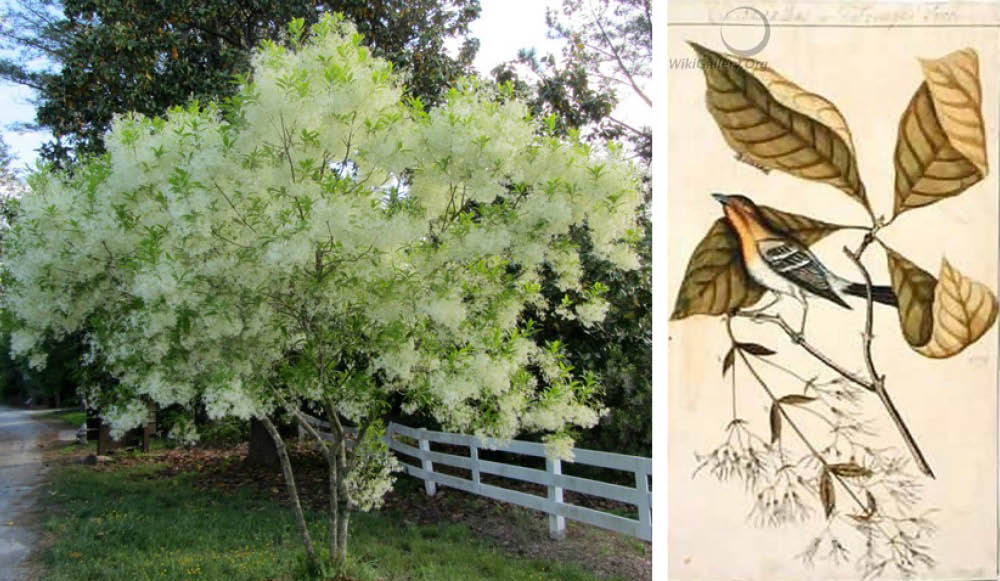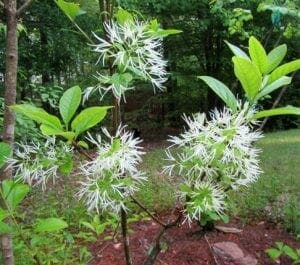2021 Plant of the Year: Fringetree

This year’s Plant of the Year (POY) is fringetree (Chionanthus virginicus). Also known as white fringe tree, old man’s beard, or grancy graybeard, this small flowering tree grows along the east coast from New York to Florida and across the south to Texas. It was first collected as a botanical specimen in 1678 by John Banister, a young clergyman with an interest in natural history. He was appointed by the Lord Bishop of London to both minister to the colony of Virginia and explore its native flora and fauna, hence the species name virginicus. Botanist John Bartram identified the plant in the 1730s during travels in the northeast. He and his son, William, a naturalist and illustrator, later collected the species further south during a 1765-66 expedition across the Carolinas, Georgia, and Florida. The image above depicts a lovely oil painting of fringetree created by William Bartram (a wiki watermark in the photo could not be removed for copyright reasons). Thomas Jefferson, a contemporary of John Bartram, was notably fond of fringetree. During his residence in London, Jefferson wrote to Bartram, requesting seeds to share with friends in France. A legacy of their collecting remains. Fringetree still grows at both Jefferson’s Virginia home, Monticello, and John Bartram’s garden in Philadelphia.

In the wild, fringetree can be found in a variety of environments, including moist, open woods, pine scrubs, and granite outcrops. It can be single or multi-trunked, with pale gray-brown bark, and an open structure. A slow-growing species, it can reach 10 to 30 feet in height and can achieve a crown spread of up to 20 feet. Its deciduous leaves are simple and opposite. They are elliptical in shape, up to 6” long, with smooth edges, glossy tops and pubescent undersides. Dark green in color, they turn yellow in the autumn.
Fringetree is best recognized for its eye-catching spring blooms, shown above. It is very late to leaf out in spring and may appear dead. But as the leaves begin to make an appearance, the tree blooms — and what a show! Individual flowers are long, white, and fine, forming copious clusters of terminal aromatic panicles. The genus name Chionanthus, meaning snow and flower, refers to the blooms.
Fringetree is most commonly planted for its ornamental appeal. The tree is well-suited to landscape borders, growing in sun or part shade and many soil types. It is a fairly non-descript tree during most of the year, but it presents a striking point of visual interest in the spring. The species has separate male and female plants, both of which exhibit the characteristic flowers. If both sexes are present, the female can produce clusters of blue-black drupes, about ½ inch long. These fruits feed the birds and are an additional source of visual appeal in the garden. Insects also benefit from fringetree. It is host to several species of native sphinx moths, including the rustic sphinx moth (Manduca rustica). Historically, fringetree also had an additional use as a medicine. A tincture of the bark was taken to stimulate the liver.
A member of the olive family, fringetree is related to several genera found in Georgia, including native ash (Fraxinus) and devilwood (Osmanthus), as well as the dread invader privet (Ligustrum). Fringetree is resistant to most pests but is susceptible to emerald ash borer, which decimates ash trees with amazing speed and efficiency. Fortunately, fringetree has some resistance to the pest. Trees are weakened by the borer and often lose limbs, but they do not always die when infested. Because of the rate at which the emerald ash borer is currently spreading, it is very important not to buy fringetree plants from states where an infestation has been reported, or to transplant even healthy specimens from infested areas. In Georgia, infestations are prevalent in the northern half of the state, especially metro Atlanta. Fortunately, our beautiful POY2021 can be grown from seed.
Text by Valerie Boss. Illustrations by William Bartram and Ellen Honeycutt.
